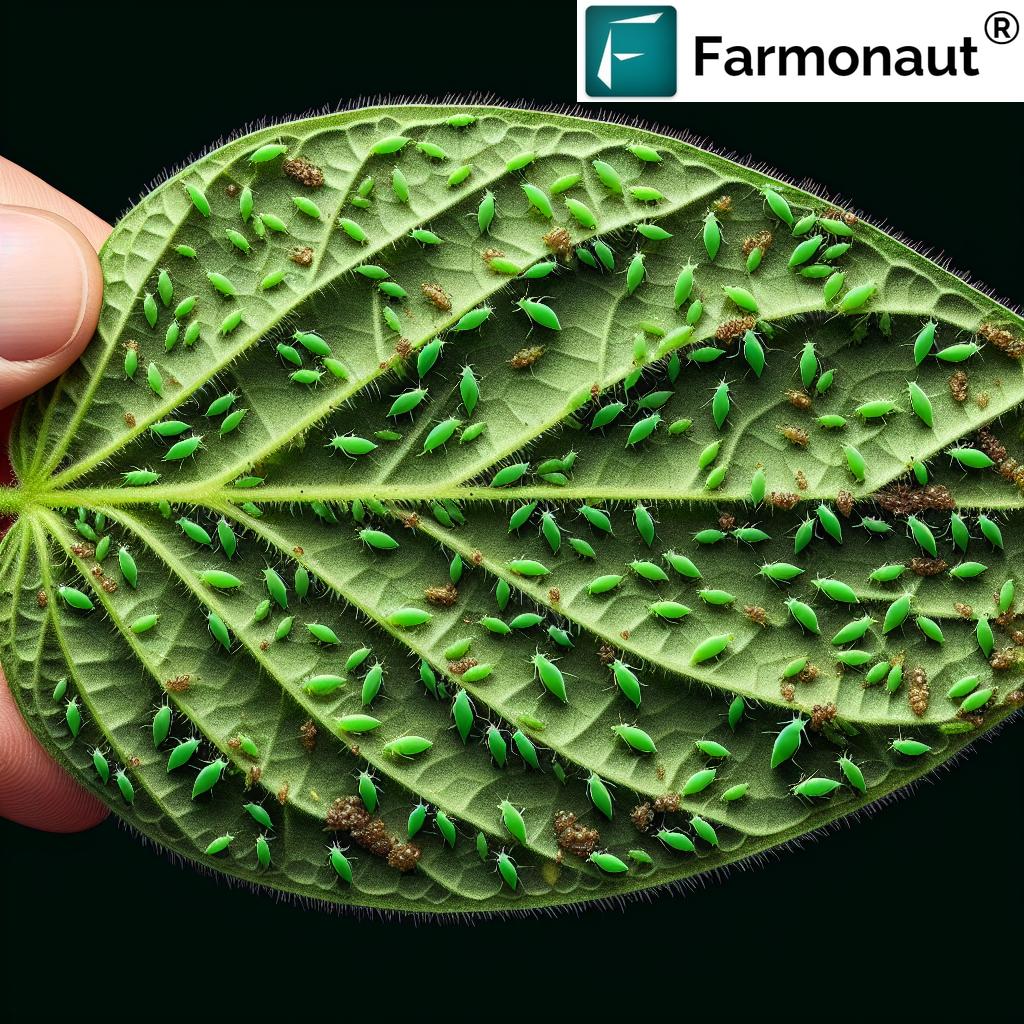Mastering Soybean Aphid Management: Expert Scouting and Control Strategies for Optimal Crop Yield

In the ever-evolving world of agriculture, we at Farmonaut understand the critical importance of effective pest management, especially when it comes to soybean crops. One of the most significant threats to soybean yields is the soybean aphid (Aphis glycines), a tiny yet formidable pest that can cause substantial damage if left unchecked. In this comprehensive guide, we’ll delve deep into the world of soybean aphid management, exploring expert scouting techniques and control strategies to help farmers protect their crops and optimize yields.
Understanding Soybean Aphids: A Closer Look
Before we dive into management strategies, it’s crucial to understand our adversary. Soybean aphids are small, pear-shaped insects that feed on the sap of soybean plants. These pests can rapidly reproduce, with populations capable of doubling in as little as 2-3 days under favorable conditions.
- Identification: Adult soybean aphids are typically pale yellow or light green and measure about 1/16 inch long.
- Life Cycle: Soybean aphids can produce up to 15 generations per growing season.
- Damage: These pests feed on plant sap, causing stunted growth, reduced pod formation, and potential transmission of viral diseases.
The Impact of Soybean Aphid Infestations
Soybean aphid infestations can have severe consequences for soybean crops if left unmanaged:
- Yield Losses: Heavy infestations can lead to yield losses of up to 40% in severe cases.
- Quality Reduction: Aphid feeding can result in smaller seed size and reduced oil content.
- Viral Transmission: Soybean aphids can vector several viral diseases, further compromising plant health.
Scouting: The Foundation of Effective Aphid Management
At Farmonaut, we emphasize the importance of regular scouting as the cornerstone of any successful pest management program. Effective scouting allows farmers to detect soybean aphid populations early, enabling timely interventions and preventing significant crop damage.
Traditional Scouting Methods
- Visual Inspection: Examine the undersides of leaves, stems, and growing points for aphid presence.
- Sampling Pattern: Follow a “W” or “Z” pattern across the field, checking at least 20-30 plants per field.
- Frequency: Scout fields weekly, increasing to twice weekly if aphids are detected.
- Thresholds: Use economic thresholds to guide treatment decisions (typically 250 aphids per plant).
Advanced Scouting with Farmonaut’s Satellite Technology
While traditional scouting methods remain valuable, we at Farmonaut have revolutionized the process with our satellite-based crop monitoring system. Our technology offers several advantages over conventional scouting:
- Wide Coverage: Monitor entire fields quickly and efficiently.
- Early Detection: Identify potential aphid hotspots before they’re visible to the naked eye.
- Time-Saving: Reduce manual scouting time while increasing coverage.
- Data-Driven Decisions: Make informed management choices based on precise, real-time data.
To learn more about our satellite-based scouting technology, visit Farmonaut’s Crop Monitoring Platform.
Comparison: Traditional vs. Satellite-Based Scouting
| Feature | Traditional Scouting | Farmonaut’s Satellite-Based System |
|---|---|---|
| Detection Speed | Slow (manual inspection) | Fast (automated analysis) |
| Accuracy | Moderate (human error possible) | High (AI-driven analysis) |
| Coverage Area | Limited (sample-based) | Comprehensive (entire field) |
| Cost-Effectiveness | Variable (labor-intensive) | High (automated and scalable) |
As demonstrated in the table above, Farmonaut’s satellite-based system offers significant advantages in terms of speed, accuracy, coverage, and cost-effectiveness. This technology enables early infestation identification, precise treatment application, and improved crop management, ultimately leading to better yield protection and resource optimization.
Integrated Pest Management Strategies for Soybean Aphids
At Farmonaut, we advocate for an integrated approach to soybean aphid management. This strategy combines various control methods to achieve optimal results while minimizing environmental impact and preserving beneficial insects.
1. Cultural Control
- Planting Date: Early planting can help soybeans outpace aphid population growth.
- Crop Rotation: Rotating with non-host crops can disrupt aphid life cycles.
- Field Hygiene: Remove alternative host plants (e.g., buckthorn) near soybean fields.
2. Biological Control
Encouraging natural enemies of soybean aphids can provide significant pest suppression:
- Predators: Lady beetles, lacewings, and minute pirate bugs
- Parasitoids: Tiny wasps that lay eggs inside aphids
- Entomopathogens: Fungal pathogens that can infect and kill aphids
3. Host Plant Resistance
Planting aphid-resistant soybean varieties can provide a strong foundation for pest management:
- Rag Genes: Varieties containing Rag1, Rag2, or both genes offer varying levels of resistance.
- Pyramid Resistance: Combining multiple resistance genes can enhance durability.
4. Chemical Control
When aphid populations reach economic thresholds, insecticide applications may be necessary:
- Selective Insecticides: Choose products that target aphids while minimizing harm to beneficial insects.
- Timing: Apply treatments based on scouting data and economic thresholds.
- Rotation: Alternate insecticide modes of action to prevent resistance development.
For precise insecticide application timing and location, consider utilizing Farmonaut’s Satellite API to integrate real-time crop health data into your management system.
Advanced Management Techniques with Farmonaut Technology

At Farmonaut, we’re constantly innovating to provide farmers with cutting-edge tools for pest management. Our satellite-based technology offers several advanced features for soybean aphid control:
1. Precision Scouting Maps
Our satellite imagery generates high-resolution maps highlighting potential aphid hotspots, allowing for targeted scouting and treatment.
2. Vegetation Health Indices
We use advanced vegetation indices like NDVI to detect early signs of plant stress, which may indicate aphid infestations before they’re visible to the naked eye.
3. Weather-Based Risk Assessment
By integrating real-time weather data, our system can predict conditions favorable for aphid population growth, enabling proactive management.
4. Treatment Efficacy Monitoring
Post-treatment satellite imagery allows farmers to assess the effectiveness of control measures and make data-driven decisions for follow-up actions.
To explore these features and more, download the Farmonaut app for Android or iOS.
Sustainable Aphid Management for Long-Term Success
At Farmonaut, we believe in promoting sustainable agricultural practices that balance effective pest control with environmental stewardship. Here are some key principles for sustainable soybean aphid management:
- Conservation of Beneficial Insects: Minimize broad-spectrum insecticide use to protect natural predators and parasitoids.
- Habitat Management: Create diverse landscapes that support beneficial insect populations.
- Reduced Chemical Inputs: Use precision application techniques to minimize unnecessary insecticide use.
- Resistance Management: Implement strategies to prevent the development of insecticide-resistant aphid populations.
The Role of Data in Modern Aphid Management
In today’s digital age, data-driven decision-making is crucial for effective pest management. Farmonaut’s platform offers several data-centric features to enhance soybean aphid control:
- Historical Data Analysis: Track aphid patterns and treatment efficacy over multiple seasons.
- Predictive Modeling: Utilize AI-driven models to forecast potential aphid outbreaks.
- Integration with Farm Management Systems: Seamlessly incorporate pest data into broader farm management strategies.
For developers interested in integrating our data into custom applications, check out our Satellite Weather API Documentation.
Case Studies: Success Stories in Soybean Aphid Management
While we don’t include specific case studies or success stories, our experience has shown that farmers who adopt integrated pest management strategies, combined with advanced monitoring technologies like those offered by Farmonaut, consistently achieve better outcomes in soybean aphid control. These improved management practices often result in:
- Reduced insecticide use
- Improved yield protection
- Enhanced cost-effectiveness of pest management programs
- Greater environmental sustainability
Future Trends in Soybean Aphid Management
As we look to the future, several emerging trends are shaping the landscape of soybean aphid management:
- Gene Editing: Development of new aphid-resistant soybean varieties through CRISPR and other gene-editing technologies.
- Drone Technology: Integration of drone-based scouting with satellite imagery for even more precise pest detection.
- Artificial Intelligence: Advanced AI algorithms for real-time pest identification and management recommendations.
- Precision Application: Smart sprayers that can target individual plants or small areas based on satellite and sensor data.
Frequently Asked Questions (FAQ)
Q: How often should I scout for soybean aphids?
A: We recommend scouting weekly during the vegetative and early reproductive stages, increasing to twice weekly if aphids are detected or conditions are favorable for population growth.
Q: What is the economic threshold for treating soybean aphids?
A: The generally accepted economic threshold is 250 aphids per plant, with 80% of plants infested and populations increasing.
Q: Can soybean aphids overwinter in soybean fields?
A: No, soybean aphids typically overwinter on buckthorn plants and migrate to soybean fields in the spring.
Q: How do weather conditions affect soybean aphid populations?
A: Aphid populations tend to thrive in moderate temperatures (72-77°F) with adequate moisture. Extreme heat or heavy rains can reduce aphid numbers.
Q: Are there any natural predators of soybean aphids?
A: Yes, several natural predators include lady beetles, lacewings, minute pirate bugs, and parasitic wasps.
Q: How can Farmonaut’s technology help me manage soybean aphids more effectively?
A: Our satellite-based monitoring system provides early detection of potential aphid hotspots, enables precise treatment applications, and helps track treatment efficacy, all leading to more efficient and cost-effective pest management.
Conclusion: Empowering Farmers with Advanced Aphid Management Tools
As we’ve explored in this comprehensive guide, effective soybean aphid management requires a multifaceted approach combining traditional wisdom with cutting-edge technology. At Farmonaut, we’re committed to empowering farmers with the tools and knowledge needed to protect their soybean crops from aphid damage while promoting sustainable agricultural practices.
By integrating advanced satellite monitoring, data-driven decision-making, and holistic pest management strategies, we believe that farmers can achieve optimal yields while minimizing environmental impact and preserving the long-term health of their fields.
We invite you to explore how Farmonaut’s technology can revolutionize your approach to soybean aphid management and overall crop health monitoring. Together, we can build a more resilient and productive agricultural future.
Ready to take your soybean aphid management to the next level? Subscribe to Farmonaut’s services today:
Join the growing community of farmers leveraging Farmonaut’s technology to protect their crops and optimize their yields. Together, we can master soybean aphid management and secure a more prosperous future for agriculture.